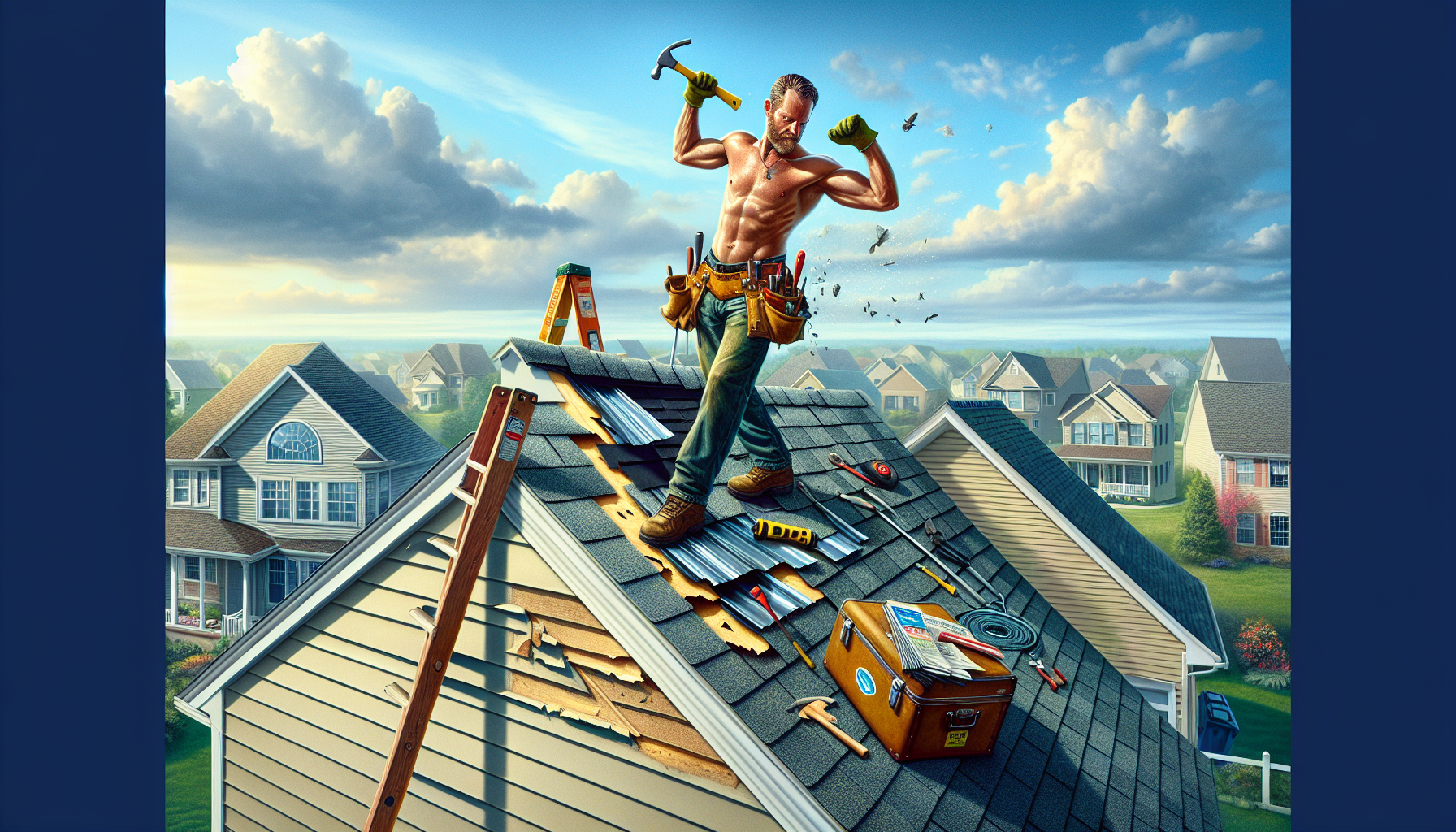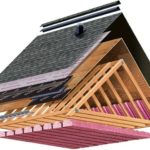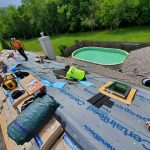In my blog post, I discuss my journey of renovating my house roof all on my own, from start to finish—from removing the shingles to putting in the fresh ones! I go into all the details, like the hurdles I encountered and the joy of successfully finishing a big DIY task! Come with me as I chat about how I revamped my roof and share insights gained throughout the process.
Table of Contents
Introduction to Reroofing
Repairing the roof is an aspect of caring for your home that can improve its worth and shield it from weather conditions and environmental factors such as rain and sun exposure. Properly re-proofing your house is vital whether you are facing issues, like leaks or damages, or just aiming to give your home a fresh look. This task involves replacing the current roofing material and requires thorough preparation and precise implementation.
Understanding the fundamentals of reroofing is key to ensuring your project goes smoothly and yields results. It’s more than just about looks. It’s also about enhancing the safety and durability of your home. Let’s take a closer look at the essential elements of this important DIY task.
️ Preparing for the Reroofing Project
When you’re getting ready to redo the roof of your house, it’s important to plan and set a timeline that works with your schedule and the weather forecast in mind, too, since reroofing can be a day project with possible delays if not properly planned for.
- Check local building codes and regulations.
- Notify neighbors about the upcoming project.
- Ensure you have the necessary permits if required.
Gather all your supplies beforehand to save time and avoid delays during installation.
Assessing the Current Roof Condition
Before removing roofing materials from your roof structure, it is crucial to evaluate the state of your roof’s condition first and foremost. During this evaluation, take note of any indications of harm, such as drooping areas or leaks, as well as any absent shingles. This thorough assessment will clarify the scope and scale of the repairs and renovations required.
- Inspect for water damage inside your home.
- Check the roof surface for cracks or missing shingles.
- Evaluate the condition of the underlayment.
Investing some effort into inspecting your roof can help you decide whether a mere shingle replacement suffices or if a full reroof is in order, which will direct your actions.
️ Gathering Necessary Tools and Materials
For a reroofing project to go smoothly, it’s essential to have the tools and materials on hand.d Here is a rundown of items you might find helpful;
- Roofing shingles
- Roofing nails
- Hammer or nail gun
- Utility knife
- Measuring tape
- Safety harness and helmet
- Ladder
Ensure all your equipment is functioning well before you begin the task. It’s worth investing in top-notch materials, as they will yield long-term benefits by guaranteeing the longevity of your installed roof for years ahead.
Tearing Off the Old Roofing Layers
The following task involves removing the existing roofing material, which might require effort but is essential for a proper reroofing job to proceed smoothly. Start by peeling off the shingles and underlayment while being cautious to avoid harming the structure beneath them.
- Start at the peak of the roof and work your way down.
- Use a pry bar to lift shingles and nails.
- Dispose of old materials responsibly.
Before starting the new roof installation, make sure to gather the debris and prepare a spot to dispose of the roofing materials.
️ Installing New Roof Deck and Sheeting
After removing the old materials and debris from the roof, the space is cleared out. Prepare for the next step—laying down the new roof deck. Sheeting is crucial as it serves as a solid base for your upcoming roofing installation project; opt for top-notch plywood or oriented strand board materials for this part of the process.
- Ensure the surface is clean and dry before installation.
- Lay the new sheeting perpendicular to the rafters.
- Secure with nails or screws according to local codes.
Ensuring that the roof deck is properly installed is crucial for your roof’s stability and lasting durability, so taking your time and ensuring everything is aligned accurately is important.
Applying Tar Paper and Ice Guard
Applying tar paper and ice guard is essential when safeguarding your home against water damage, matey! These materials shield against moisture, helping your roof stand the test of time.
- Start at the bottom edge of the roof and work your way up.
- Overlap each row of tar paper for maximum protection.
- Install ice guards in areas prone to ice damming.
Seal all the seams to avoid leaks. This is crucial to ensuring your roof can effectively withstand weather conditions.
Shingle Installation Process
After the underlayment has been properly laid down, shingle installation is essential. This stage significantly influences the roof’s appeal and effectiveness.
Start by placing the shingles along the roof edge, ensuring they are well aligned to keep water from getting in underneath them. They are accurately placed using a chalk line to maintain uniformity in each row.
- Start from one side and work your way across the roof.
- Use roofing nails to secure each shingle, following the manufacturer’s guidelines.
- Stagger the seams of each row for better water resistance.
Feel free to spend time on this task, as an installed shingle roof has the potential to endure for many decades and safeguard your home against various weather conditions.
Photo by Nakaharu Line on Unsplash
️ Building Out Overhangs and Adding Fascia Boards
Adding eaves and installing fascia boards is a part of improving the practicality and visual appeal of your roof structure, as they help redirect rainwater and offer shelter from the sun’s rays.
To create overhangs on your house’s roof deck by extending it beyond the wall, you must cut and securely fasten sheeting in place.
- Measure the desired length of the overhang carefully.
- Cut the sheeting accordingly and secure it with nails.
- Install fascia boards along the edges for a finished look.
Make sure to treat or paint the fascia boards to improve their look and shield the underlying structure from potential water damage caused by the elements.
Photo by Francesco Mocellin on Unsplash
⚠️ Challenges Faced During the Reroofing Process
Every DIY project has its share of obstacles.I faced challenges that pushed my patience and abilities to the limit while working on re-roofing my home.
- Weather conditions fluctuated, causing delays.
- Removing old shingles revealed unexpected damages that needed repair.
- Working at heights required extra caution and time.
Every obstacle I faced taught me lessons on being ready and flexible, showing that tackling these challenges is a part of the do-it-yourself journey.
Photo by Gyan Shahane on Unsplash
Final Inspection and Clean Up
Following the installation of the shingles, it is important to conduct an inspection to confirm the installation and check for potential leaks or loose shingles.
Take a stroll along the rooftop. Inspect for any problems. Evaluate the edges, dips, and openings carefully, as they are spots where leaks can occur.
- Inspect the entire roof surface for any misplaced shingles.
- Check that all nails are properly secured and not exposed.
- Ensure that the gutters are clear of debris from the installation process.
Following the inspection, make sure to tidy up the workspace and dispose of any materials and debris properly. This is crucial for safety reasons and to maintain a clean and organized environment to prevent accidents.
Photo by Pau Sayrol on Unsplash
✨ Conclusion and Reflections on the Project
Finishing the roof replacement task was quite tough yet fulfilling at the time. I gained knowledge about roofing and home upkeep and felt a sense of pride in what I achieved.
Through this journey, I learned the value of getting ready in advance and staying persistent despite challenges when re-roofing my house—not only did it enhance its look, but it also secured its safety for the future.
If you’re thinking about tackling a project like the one I did here with your house’s roof renovation, go for it! With the tools at hand and some solid planning and perseverance, you can definitely pull off a reroofing job on your own home.
Photo by Hunter Haley on Unsplash
❓ FAQs About Reroofing
As you begin to re-roof your home or build a roof installation project, you might ponder inquiries that commonly arise in such situations. Some raised queries could offer insights and guidance as you navigate this process.
- How long does it take to reroof a house? The time varies based on the size of the roof and your experience. On average, it can take several days to complete.
- Can I re-roof over existing shingles? Yes, but it’s recommended that old shingles be removed for a better seal and longevity.
- What type of shingles should I use? Asphalt shingles are famous for their cost-effectiveness and durability.
- Do I need a permit to repair my house? This depends on local regulations; check with your local building authority.
Considering these inquiries can enhance your readiness as you contemplate re-roofing your home. Remember that conducting research and proper preparation are elements of a project’s success.
Photo by Ian Schneider on Unsplash




























No Comments